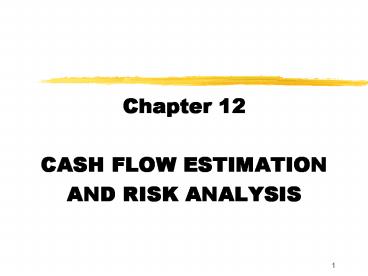CASH FLOW ESTIMATION PowerPoint PPT Presentation
1 / 15
Title: CASH FLOW ESTIMATION
1
- Chapter 12
- CASH FLOW ESTIMATION
- AND RISK ANALYSIS
2
INCREMENTAL CASH FLOWS
- When estimating the cash flows for a capital
budgeting project, our focus is on incremental
cash flows. - An incremental cash flow is how much the project
adds to the companys total cash flows.
3
- To make the task of estimating project cash flows
easier, we divide the task into three segments. - The initial investment outlay is the difference
in cash flow at t0 - The annual operating cash flows are the annual
cash profits - The terminal cash flow is the residual cash flow
at the end of the project
4
Consider the Information Below for a New Project
Proposal
- Equipment Cost is 95,000 plus 5,000
installation - Working capital needs Inv20,000
Acct.Rec5,000 Acct.Pay15,000 - Project 130,000 in annual sales annual variable
costs of 30 annual fixed costs of 25,000
(years 1-3) - Depreciate as 3-yr MACRS property
- Expect salvage value of 35,000 (t3)
5
- Tax rate on additional earnings 40
- Marketing survey cost 10,000 suggesting the new
machines products would be well-received by
consumers (cost has been expensed for tax
purposes) - Firms cost of capital (r) is 15
- Sales from the new project will not impact sales
of other products
6
I. Initial Outlay (CF0)
- The biggest component of the initial outlay is
the equipment cost - If working capital must be increased, this is a
cash outflow - What is this projects CF0?
7
II. Annual Operating CF (CF1-3)
- To find the annual operating cash flows, we must
construct an income statement for each future
year - Book profit (net income) is converted to cash
profit by adding back depreciation - Another name for annual cash profit is cash flow
8
III. Terminal CF (Additional CF3)
- When the project is shut down at the end of the 3
years, the fixed assets will be sold. - If the fixed assets are sold above their book
value, the company must pay tax on the gain above
book value.
9
III. Terminal CF (Additional CF3)
- Working capital will be reduced back to zero, and
the decrease in working capital will be a cash
inflow. - Although the working capital may be higher or
lower than our estimate, the default assumption
is that the working capital will be recovered at
original cost.
10
Project CF Summary
- What are this projects totoal incremental (i.e.,
relevant) cash flows? - If the project has a wacc of 15, the project
should be accepted because its NPV is greater
than zero.
11
GUIDELINES FOR ESTIMATING INCREMENTAL CASH FLOWS
- Our analysis of the project is only as accurate
as our future estimates of sales and costs.
(GIGO) - As a practical matter, it is better to place
someone in charge of the analysis who does not
have a personal interest in the projects
acceptance.
12
- Our focus should be on cash flows rather than
book profits because shareholder wealth is more
closely tied to cash flow. - Some companies will have other noncash expenses
besides depreciation, such as amortization or
depletion.
13
- Notice that we did not deduct interest expense or
dividend payments because financing costs are
captured in the projects wacc. - Notice that the cost of the marketing survey was
omitted because it was a sunk cost a cash flow
that is unaffected by whether the project is
accepted or rejected.
14
- If the project used a building that could
otherwise have been rented out, the lost rent
income would be treated as a cash outflow and
viewed as an opportunity cost. - If sales of the new product would reduce sales of
other products sold by the firm, the lost sales
would be treated as a cash outflow viewed as a
cannibalization effect or externality.
15
PROJECT RISK CONSIDERATIONS
- If the projects risk is considered above average
for the company, then we should increase the
wacc. - One way to examine risk is to try different
possible sales prices for our project and observe
the NPV each produces. This is referred to as
sensitivity analysis.

